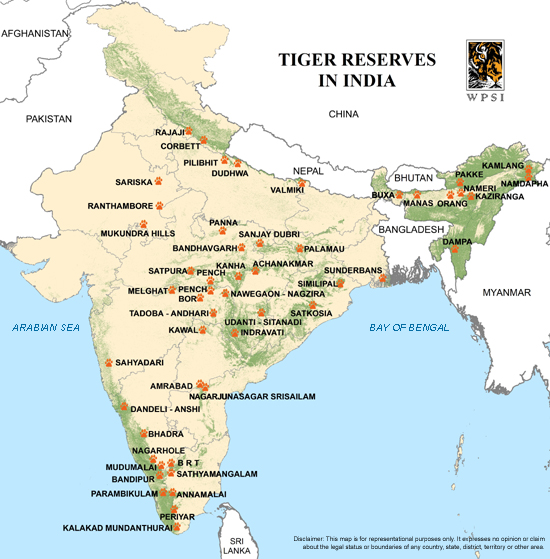The Big Picture: Importance of Tiger Conservation | 06 Aug 2020
The tiger population across the world dropped sharply since the beginning of the 20th century but now for the first time in conservation history, their numbers are on the rise.
- India has 70% of the global tiger population.
- The International Tiger Day celebrated on 29th july is an annual event marked to raise awareness about tiger conservation.
- First international Tiger’s day was celebrated in 2010 at the St. Petersburg Tiger Summit.
St. Petersburg Declaration on Tiger Conservation
- This resolution was adopted In November 2010, by the leaders of 13 tiger range countries (TRCs) assembled at an International Tiger Forum in St. Petersburg, Russia
- It aimed at promoting a global system to protect the natural habitat of tigers and raise awareness among people on white tiger conservation.
- The resolution’s implementation mechanism is called the Global Tiger Recovery Program whose overarching goal was to double the number of wild tigers from about 3,200 to more than 7,000 by 2022.
- 13 Tiger range countries are: Bangladesh, Bhutan, Cambodia, China, India, Indonesia, Laos, Malaysia, Myanmar, Nepal, Russia, Thailand and Vietnam.
Encouraging Factors in Conservation of Tigers
According to the Tiger Census Report, 2019, the Tiger population has substantially increased from 2,226 in 2014 to around 2,967 in 2019.
Key Findings
- Top Performers: Madhya Pradesh saw the highest number of tigers (526) followed by Karnataka (524) and Uttarakhand (442).
- Increase in Tiger population: Madhya Pradesh (71%) > Maharashtra (64%) > Karnataka (29%).
- Worst Performers: Chhattisgarh and Mizoram saw a decline in tiger population.
- Chhattisgarh is the only state out of the 20 tiger-bearing states where the 2018- census counted 19 tigers, significantly fewer than the 46 of 2014.
- Decline in Tiger numbers in Chhattisgarh can be attributed to the law and order problem as large parts of the state are hit by the Maoist insurgency.
- Greater conservation efforts are needed in the “critically vulnerable” Northeast hills and Odisha.
- The first ever initiative for the conservation of tigers was the Project Tiger.
- There are 50 tiger reserves within the country. Out of 50 tiger reserves in the country, three reserves - Mizoram’s Dampa reserve, Bengal’s Buxa reserve and Jharkhand’s Palamau reserve - have no tigers left.
Project Tiger
- Project Tiger is a Centrally Sponsored Scheme of the Ministry of Environment, Forests and Climate Change launched in 1973 to provide central assistance to the tiger States for tiger conservation in designated tiger reserves in India. The project is administered by the National Tiger Conservation Authority (NTCA).
National Tiger Conservation Authority
- National Tiger Conservation Authority (NTCA) is a statutory body under the Ministry of Environment, Forests and Climate Change.
- It was established in 2005 following the recommendations of the Tiger Task Force.
- It was constituted under enabling provisions of the Wildlife (Protection) Act, 1972, as amended in 2006, for strengthening tiger conservation, as per powers and functions assigned to it.
Significance of Tiger Conservation
- Tiger is one of the prime predators on which the whole ecosystem depends; by ensuring the protection of tigers, the balance of the ecosystem is also ensured.
- Tiger is an umbrella species whose conservation eventually leads to the conservation of many other species such as the ungulates, pollinators and other small animals.
- In the IUCN red list, Tigers are listed in the category of endangered species.
- There is a tremendous decline in the tiger population as compared to the past 100 years and to prevent the deteriorating condition of tigers, it’s important to conserve them.
Umbrella Species
- These are species that are selected for conservation-related decisions because the conservation and protection of these species indirectly affect the conservation and protection of other species within their ecosystem. Umbrella species help in the selection of potential reserve locations, as well as the determination of the composition of the reserve.
Challenges
Although, we are moving progressively towards conserving more and more tigers, but few threats are still there standing as a resistance in the conservation practices:
- Three tiger reserves of India: Mizoram's Dampa reserve, West Bengal's Buxa reserve and Jharkhand's Palamau reserve have no tigers left.
- The tiger reserves are having a poor interconnectivity with each other due to which the gene exchange among the tiger population can barely take place.
- There has occurred a human-tiger conflict as the tiger conservation practice has grown but their natural habitats are already shrinking and hence, they are seeking their habitat in the human habitation.
- Poaching of tigers is taken as a pride and every part of tiger has a market value therefore they are being hunted indiscriminately for personal as well as commercial purpose.
- The constrained mentality of the local communities regarding tiger poaching as their only job is a major challenge to tiger conservation.
- The linear developments such as that of railways and roadways is a critical issue in creating the conservation ethos.
Way Forward
- Only laws and the technical expertise are not enough, on the local communities’ part it also needs to be understood that their participation is as important.
- These local communities need to be provided better economic opportunities so that they have a better source of income than poaching of tigers.
- We have to make the environment and development co-exist and go hand in hand by planning our future developmental goals in such a manner that our environmental goals are not compromised.
- Voluntary relocation of the communities within and around these tiger reserves by ensuring justice to them regarding compensation and employment along with the conservation of the environment.
- The process of tiger conservation should be more dynamic and compatible with the future possibilities of climatic changes as well.

